Note: If you would like to customise the spoken voice or the speed and pitch at which text is spoken see the article: Android 8 Oreo - Text-to-speech output
This article is split into three sections:
Volume controls for Accessibility Services
How to enable TalkBack
To enable this feature;
- Open ‘Settings’ and choose ‘Accessibility’ (see the article Android – How to open the Accessibility Settings for more information.)
- On the Accessibility screen, under the ‘Screen readers’ section tap on ‘TalkBack’.
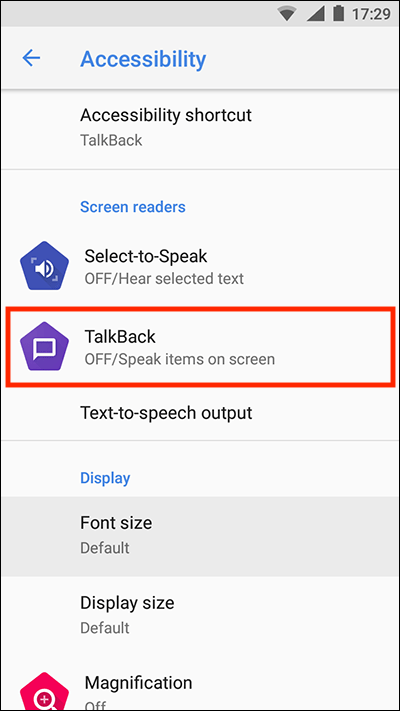
- On the next screen, Tap the on/off toggle switch to activate TalkBack.
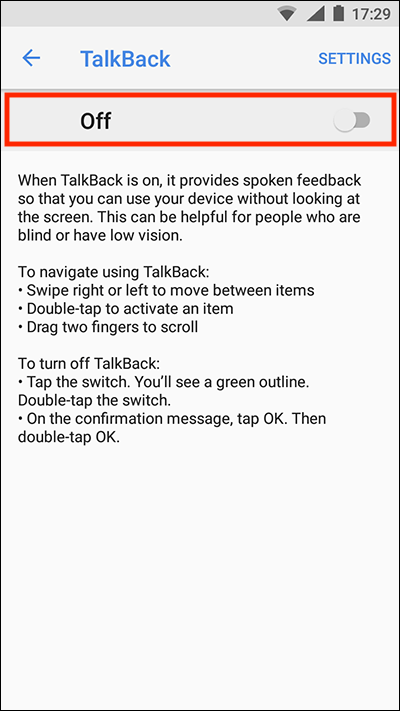
- An alert will appear on the screen asking permission for TalkBack to perform certain actions on your device. Tap OK if you are happy to proceed. (Note: you may be asked to enter your PIN or password to confirm)
- If this is the first time you have enabled TalkBack you will be presented with a tutorial screen. The tutorial consists of five lessons which will teach you how to operate TalkBack
- Tap on ‘LEARN’ for an explanation of each feature.
- Tap on ‘PRACTISE’ to try out the features covered by each tutorial.
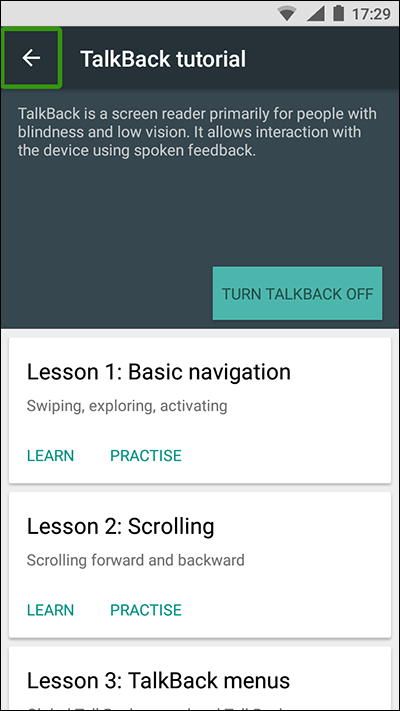
- Once you have completed a lesson you can jump to the next or previous lesson using the navigation buttons at the bottom of the window.
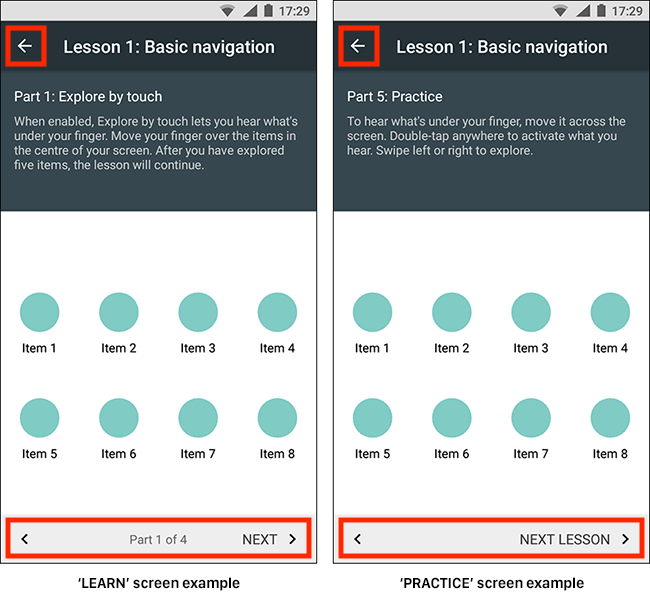
- To go back to the main tutorial window, tap the back arrow next to the lesson name at the top of the screen. Note: If you would like to revisit the ‘TalkBack tutorial’ at a later time you can access it through the Talkback settings menu.
TalkBack settings
This section explains all the TalkBack settings you can customise. The following steps assume you are viewing the TalkBack screen within Accessibility settings. To enable this feature tap on ‘SETTINGS’ in the top-right of the screen.
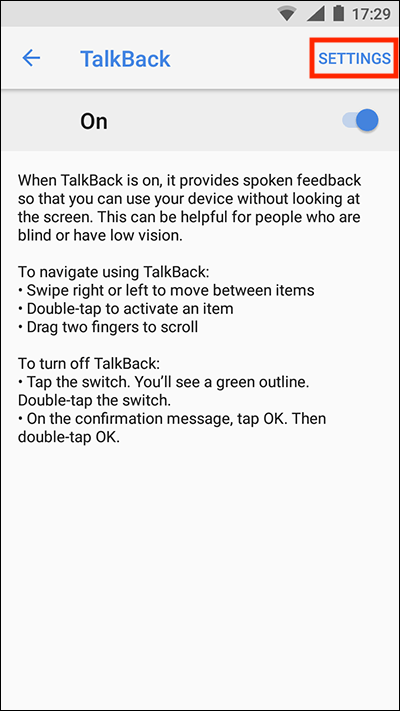
The settings options are broken down into the following categories:
Speech settings
Text-to-speech Settings
- You can change how the voice used for feedback sounds via the text-to-speech settings. Tap ‘Text-to-speech Settings’.
- Use the ‘Speech rate’ and ‘Pitch’ sliders to adjust the TalkBack voice to your liking.Note: For further information on changing ‘Text-to-speech settings’ see the article: ‘Android 8 Oreo - Text-to-speech’
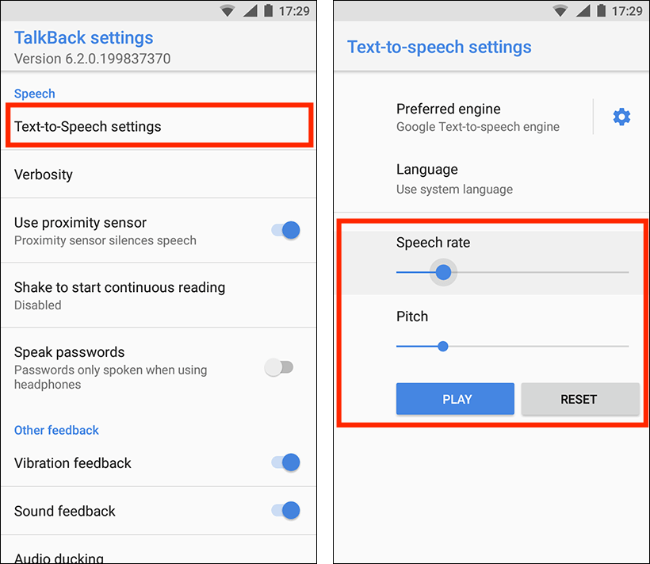
Verbosity
Google Assistant has three pre-set levels of spoken feedback – ‘High’, ‘Custom’ and ‘Low’. By default, ‘Verbosity’ is set to ‘Custom’ giving you various options that you can toggle on and off. To change the settings tap on ‘Verbosity’.
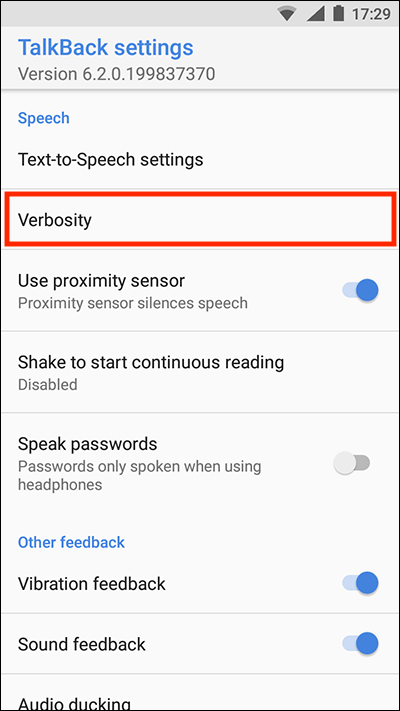
To change the spoken feedback pre-set, tap on ‘Choose a preset’ and select from
- High
- Custom
- Low
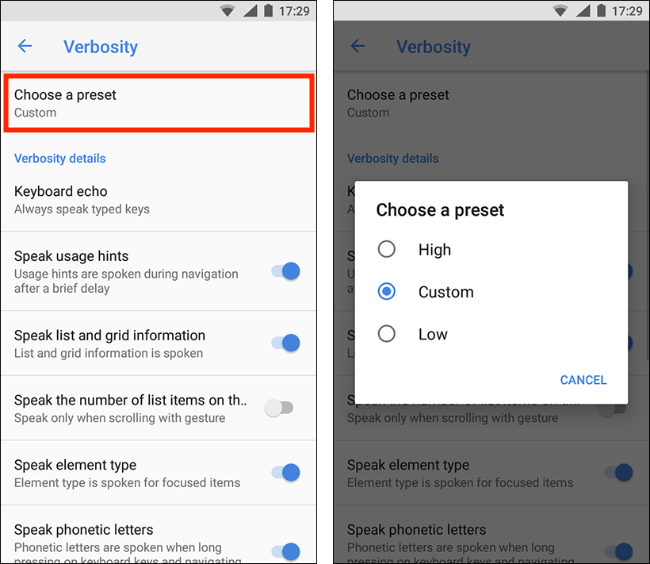
If you have selected ‘custom’ you will be able to customise a range of settings relating to how much spoken feedback is provided including the following:
Verbosity -> Keyboard Echo
By default TalkBack will always read aloud which key is being pressed. To change this setting tap on ‘Keyboard Echo’ and choose from:
- Always speak typed keys
- Only for on-screen keyboard
- Never speak typed keys
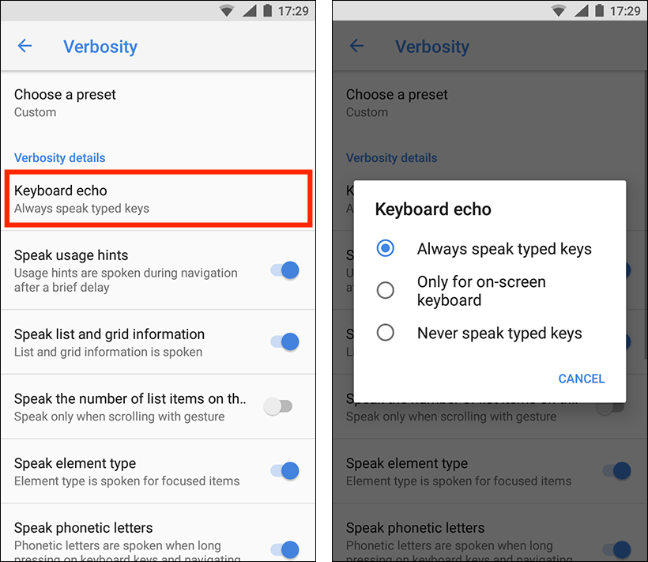
Verbosity -> Element description order
You can change the order in which TalkBack describes the item you have selected. By default, the order is ‘State, name, type’.
Scroll down to the Miscellaneous section and tap ‘Element description order’ to change this and choose from:
- State, Name, Type
- Type, Name, State
- Name, Type, State
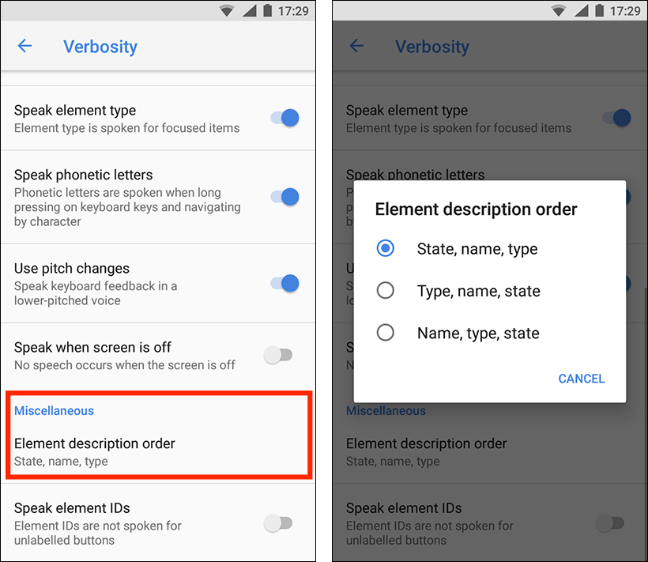
All other Verbosity settings can be turned on or off by tapping on their respective toggle switches.
Use proximity sensor
If your device has a proximity sensor you can set TalkBack to be silenced when it is touched or picked up.
- Tap the on/off toggle switch next to ‘Use proximity sensor’.
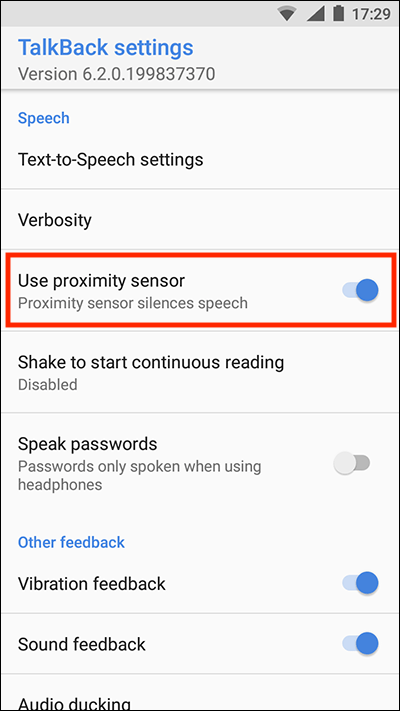
Shake to start continuous reading
You can set TalkBack to start continuously speaking the items on the screen when you shake your device. By default, this is disabled.
To change this, tap on ‘Shake to start continuous reading’ and choose from the following list how hard you need to shake your device.
- Disabled
- Very light
- Light
- Medium
- Hard
- Very hard
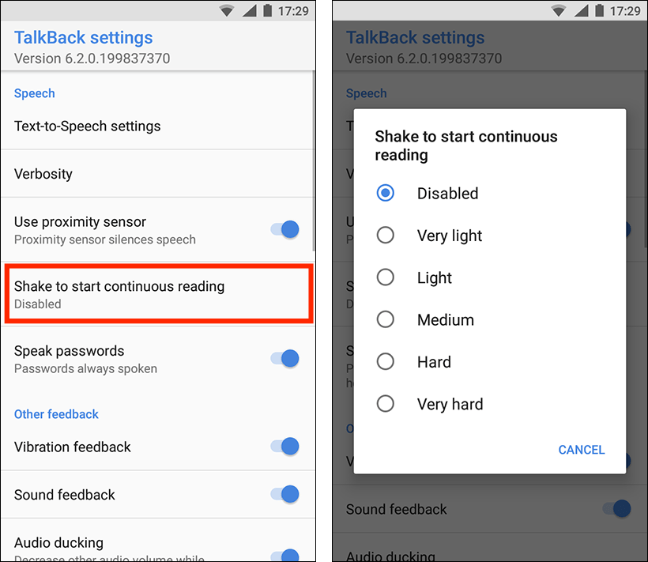
Speak passwords
By default, TalkBack will read aloud the characters of your password as you enter them. If you would prefer to disable this feature, tap the on/off toggle switch. Note: you will still be able to hear the password characters if you are using headphones.
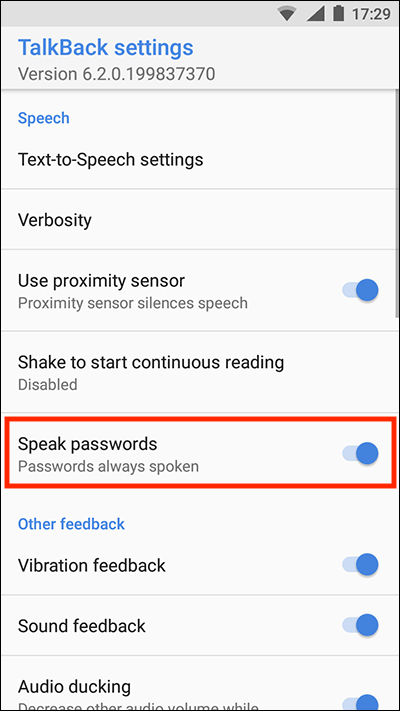
Other Feedback settings
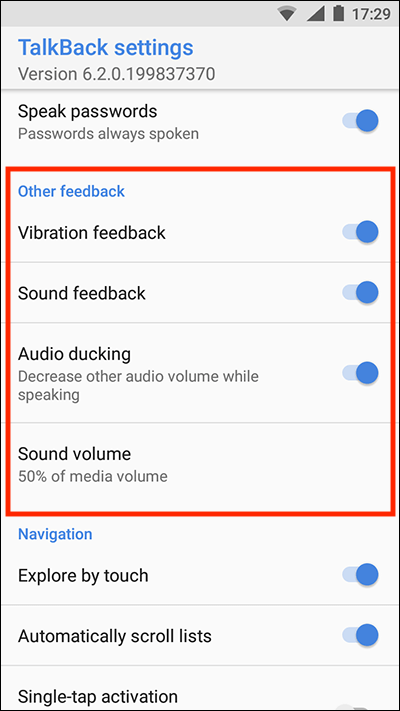
Vibration feedback
You can set your device to vibrate whenever you tap an item or navigate the screen. Tap the on/off toggle switch to enable this feature.
Sound feedback
Get feedback sounds when you are navigating the screen: e.g. you’ll hear a sound that changes in pitch as you scroll up (lower pitch) or down (higher pitch) the screen. Tap the on/off toggle switch to enable this feature.
Note: You can adjust the volume of ‘Sound feedback’ under the ‘Sound volume’ option (see below).
Audio ducking
This setting automatically decreases the volume of any other audio that is playing on your device so that spoken feedback is easier to hear.
Sound volume
You can adjust the volume of ‘Sound feedback’ (if enabled, see above) in comparison to the other media volume settings on your device. To change it, tap ‘Sound Volume’ and choose from:
- Match media volume
- 75% of media volume
- 50% of media volume
- 25% of media volume

Navigation settings
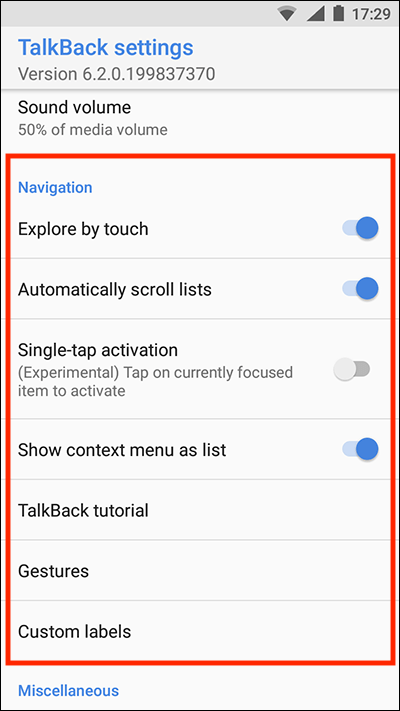
Explore by touch
By slowly dragging your finger around the screen you can receive spoken feedback of what your finger is touching. This setting is enabled by default. To change the setting tap the on/off toggle switch next to ‘Explore by touch’.
If you turn ‘Explore by touch’ off, an alert will appear asking you to confirm that you want to proceed. Tap ‘OK’ to confirm or ‘CANCEL’ to return to the Settings screen.
For more information about ‘Explore by touch’ see the Google help article: https://support.google.com/accessibility/android/answer/6006598
Automatically scroll lists
When this setting is enabled, lists will scroll by themselves.
Single-tap activation
By default, you must double-tap on a selected item to activate it. To enable single-tap activation, tap the on/off toggle switch next to ‘Single-tap activation’.
Note: ‘Single-tap activation’ is an experimental feature and may not work correctly everywhere on your device.
Show context menu as list
By default, the Talkback menus are displayed as a list of items. You can slide your finger up and down the list to hear the options. To change this to circular menus where you can slide in a circular motion to hear the options turn off the ‘Show context menu as list’ toggle switch.
For more information about context menus see the Google help article: https://support.google.com/accessibility/android/answer/6007066
TalkBack tutorial
The tutorial consists of five lessons which will teach you how to use TalkBack effectively. For more information on the tutorial see the ‘How to enable ‘TalkBack’ section. Tap on ‘Launch TalkBack tutorial’ to begin.
Gestures
Gestures enable you to navigate your device by swiping your finger in different directions across the screen.
- If you would like to change the action associated with a particular TalkBack gesture, tap on ‘Gestures’.
- A list of available gestures will appear.
- Tap on a gesture in the list to change the action that is associated with it. A list of available actions will appear.
- In our example, we tapped on ‘Swipe up’. We can now select a different action from the available list of actions.
- For more information and a full list of TalkBack gestures see the Google help article: https://support.google.com/accessibility/android/answer/6151827
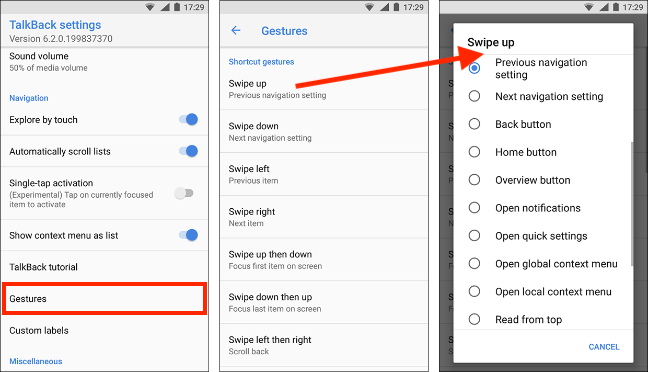
Custom Labels
You can manage any custom labels you have created through the local context menu. You can also import or export existing labels. To manage, import or export labels, tap on ‘Custom labels’.
Miscellaneous settings
Keyboard shortcuts
If you have a keyboard connected to your device, you can use keyboard shortcuts such as pressing ‘Alt’ + ‘Left Arrow’ to move to the next item on the screen. These key combinations are called ‘keymaps’ and you can choose between two sets; ‘Default’ and ‘Classic’. Most Android devices use the ‘Default keymap’ which has more shortcuts available.
The default modifier for ‘keymaps’ is the ‘Alt’ key but you can change this to the ‘Search’ key if you prefer.
To change which keymap you use and/or the modifier key:
- Tap on ‘Keyboard shortcuts’.

- To change the keymap, tap on ‘Choose a keymap’ and choose between ‘Classic keymap’ or ‘Default keymap’.
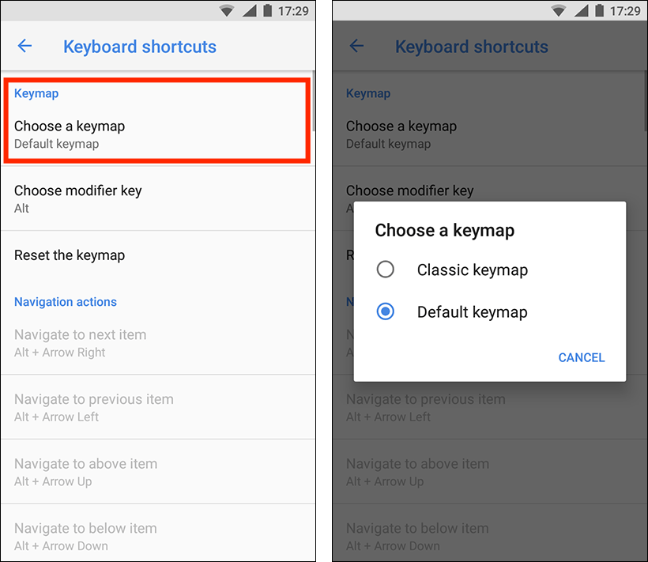
- To change the modifier key used for keyboard shortcuts, tap on ‘Choose modifier key’ and choose between ‘Alt’ or ‘Search’.

For more information and a full list of TalkBack keyboard shortcuts see the Google help article: https://support.google.com/accessibility/android/answer/6110948
When you are happy with your settings press your device’s ‘home button’ to return to the home screen.
Volume controls for Talkback
When TalkBack is enabled you’ll see a separate volume slider for changing the volume levels of spoken accessibility services. To access the Accessibility volume control press one of the volume buttons on your device. The Accessibility volume slider will appear at the top of the screen. You can adjust the level using the volume buttons or by dragging the slider with two fingers.
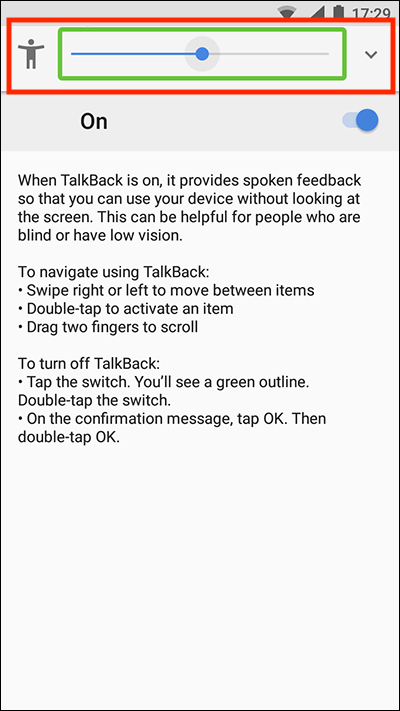
Note: These instructions apply to the standard version of Android 8 Oreo. Please be aware that many manufacturers add their own customisations to the Android operating systems so you may find minor differences from the steps shown.
Related information
To activate 'Talkback' using the Android 'Accessibility shortcut' see the article: Android 8 Oreo – Accessibility shortcut on this website.
To customise the 'TalkBack' voice, speed and pitch settings see the article:
Android 8 Oreo – Text-to-speech output on this website.
Google’s TalkBack overview: https://support.google.com/accessibility/android/answer/6283677?hl=en-GB&ref_topic=3529932
For more information about ‘Explore by touch’ see the Google help article: https://support.google.com/accessibility/android/answer/6006598
For more information about ‘Show context menu as list’ see the Google help article: https://support.google.com/accessibility/android/answer/6007066
For more information and a full list of TalkBack gestures see the Google help article: https://support.google.com/accessibility/android/answer/6151827
For more information and a full list of TalkBack keyboard shortcuts see the Google help article: https://support.google.com/accessibility/android/answer/6110948